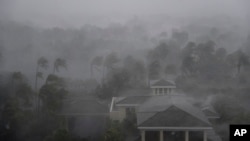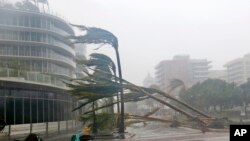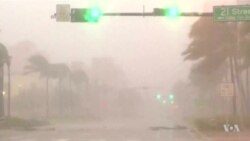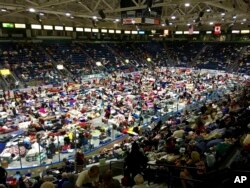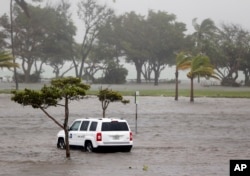More than three million people in Florida were in the dark Sunday night due to the effects of a fierce hurricane that pounded parts of the state's Gulf Coast with winds of more than 200 kilometers per hour.
Hurricane Irma weakened slightly as it moved slowly north through the third most populous U.S. state Sunday, but its swirling winds were still measured at 165 kph as darkness fell.
The storm slammed into the Florida Keys early Sunday, when it was near its greatest strength. By evening it was closing in on Tampa and St. Petersburg, the two largest cities around Tampa Bay, where a storm surge was expected to push waves of water up to three meters deep into streets, yards and homes.
A major hurricane has not hit Tampa in more than 100 years. Hurricane Irma was an unusually wide storm, and high winds and rain covered the entire Florida Peninsula, from Jacksonville south to Miami.
'Worried about lives'
President Donald Trump declared Florida a major disaster area Sunday, a step that will release federal aid funds for storm victims more quickly.
Trump, who called his Cabinet into session to see what the government can do to help hurricane victims, said he will visit the storm zone in Florida very soon. He praised rescue efforts by the U.S. Coast Guard as "amazing" and said coordination among federal, state and local agencies working on the storm was going "really well."
Asked how much Florida's recovery will cost, Trump said he is "worried about lives, not cost" at this point.
Hurricane Irma has been called the most powerful Atlantic storm ever recorded, and it delivered as advertised.
Watch related video by VOA's Michael Bowman:
Hurricanes are tropical cyclones that originate in the Atlantic Ocean Basin. In the Northern Hemisphere they form circular masses of high winds and heavy rains rotating counterclockwise. The "eye" of a hurricane is an area of calm at the center of the storm - clearly visible in satellite photographs. When the eye passes overhead a hurricane is only half over for someone on the ground, and sometimes the edge of the open eye, called the eyewall, can be the most violent area of the storm.
The National Hurricane Center predicted Irma will stay on its northern course, traveling up Florida's west coast Sunday night into Monday, then weaken further as it pushes deeper inland in southern Georgia.
Hurricane Irma was a maximum-strength hurricane - category five on a five-point scale that the U.S. follows - when it first crashed into the Leeward Islands in the Caribbean last week. It weakened to a category four storm when it grazed Cuba, and then was measured at category three, but regained strength over warm open waters between Cuba and Florida and was listed as category four again on Sunday. Later on Sunday it was downgraded to a category two storm, but was considered still dangerous.
At least six tornadoes and several waterspouts were sighted in and around the Miami area Sunday, and Miami Beach, usually bustling with tourists, surfers, and swimmers, was a rain-soaked ghost town. Streets in downtown Miami were flooded.
Graceful palm trees, a trademark of "the sunshine state," became hazards as gusts turned leaves, branches, and coconuts into wind-blown weapons.
‘I want everybody to survive’
Florida Governor Rick Scott, a familiar face to all Americans from his frequent live appeals on television about evacuation orders and other precautions, said Sunday was no time for anyone to relax: "I want everybody to survive this storm. I want everybody to be safe. During the storm, as you know, we can’t send out first responders to save you."
Scott also repeated his call for nurses and emergency workers to volunteer their help in the aftermath.
More than 75,000 people checked into 400 emergency shelters statewide, but overall, only three storm-related deaths were reported in Florida through late Sunday. At least 25 people have been killed since Irma clobbered the Caribbean late last week.
Prime Minister Gaston Browne of Antigua and Barbuda says 95 percent of Barbuda's buildings were either destroyed or severely damaged. Reporters who flew over the island agreed with his assessment.
The U.S. territory of Puerto Rico suffered losses in its electricity network that blacked out more than one million people. Authorities said it could take up to six months to rebuild the island's power grid.
The Pentagon deployed Navy ships and aircraft and hundreds of Marines to help with recovery efforts in Puerto Rico and the U.S. Virgin Islands, and the U.S. Air Force flew evacuation flights to Puerto Rico and to the Dutch Caribbean island of St. Maarten, which also suffered severe damage.
Netherlands' king is reported to be headed to St. Maarten to assist in recovery efforts, and French President Emmanuel Macron said he would be arriving in St. Martin aboard an Airbus plane packed with aid supplies.
France and the Netherlands share jurisdiction over the island that is home to St. Martin and St. Maarten. The smaller French island of St. Barthelemy, which is nearby, also was badly damaged.




